Oh, Happy Tuesday! Today we’re going to look at an embroidery design book that came out earlier this year. But before we launch into my review, I have a wee bit of news to cover.
First, we’re pushing out some changes today to my online shop here on Needle ‘n Thread, so there may be a couple hiccups on the site, but hopefully not! I’m excited about the new layout – it should make it easier to keep the shop organized and easier for you to find things. Yay!
Second, I’m taking a short break for the next week, and I will have limited internet connectivity. I have some articles scheduled – including some project finishes – but I won’t be able to respond to email or moderate comments as frequently. I’ll check in as I can.
And now, for the book!
If you tend to hesitate to jump into an embroidery project because of the transfer process, then you’re going to love this! If you like source books for embroidery designs, you’re also going to love it.
The Embroiderers’ Guild Transfers Collection is a unique book, so let’s look at it a little more closely.
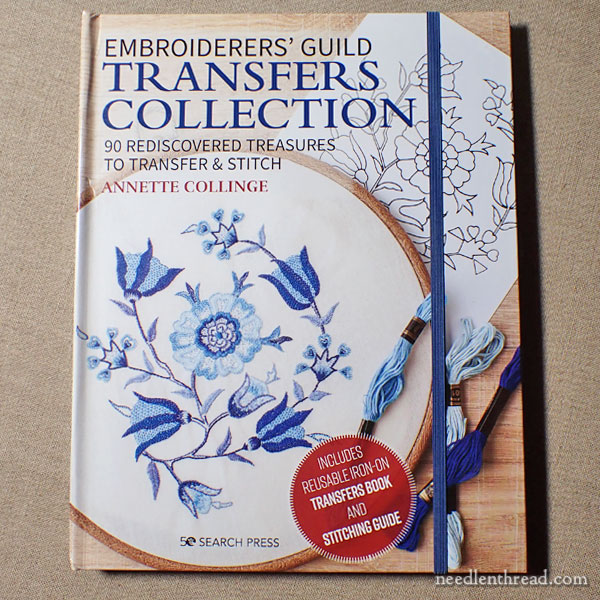
The outside of the collection looks like a hard-bound book with an elastic band that holds it neatly closed, like the band you’d find on a Moleskine notebook.
But really, it’s more of a folio:
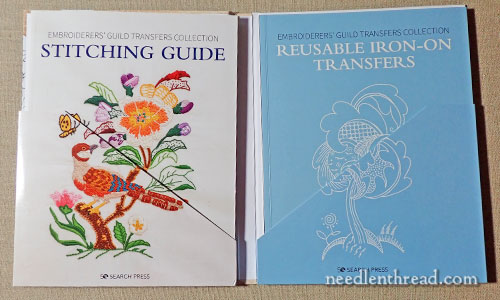
When you open it up, you’ll find two sturdy pockets, one on each side of the spread, and in those pockets are two separate books.
The book on the left is the Stitching Guide, and the book on the right is the collection of reusable iron-on transfers.
Let’s look at the Stitching Guide first!
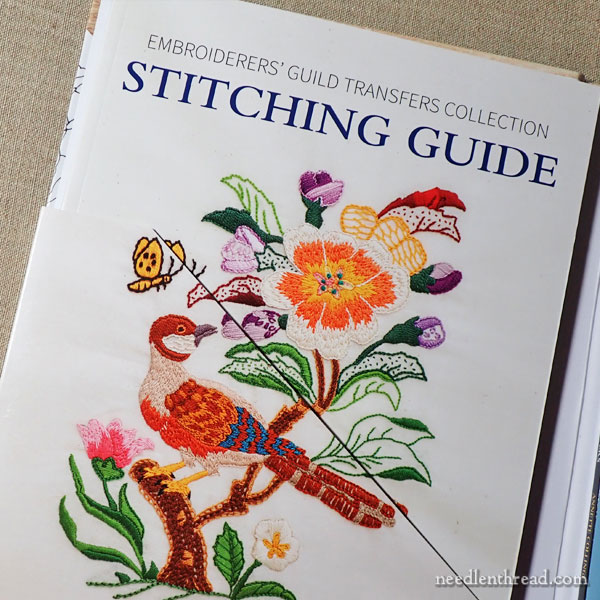
At the beginning of the Stitching Guide, you’ll find an interesting history on the hot-iron transfer collection belonging to the Embroiderers’ Guild. I think perhaps this is the only aspect of the book that I found somewhat … mmmm…. negative.
It is not a complete history of iron-on transfers, but rather just a short history of the Guild’s collection.
I’ve read this section several times. I think it’s the first time in the “history” part of an embroidery book where I find myself thinking it is poorly done. I find it one-sided, especially if you’re looking for a solid history of the development of iron-on transfers and a wider viewpoint.
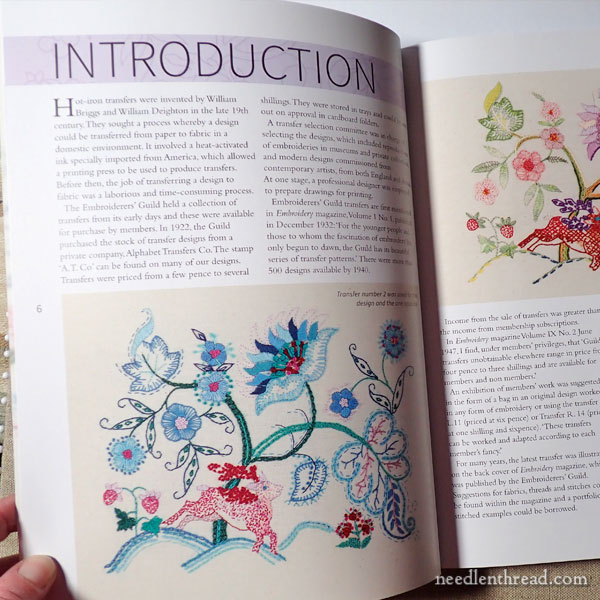
This little history seems to give the impression that the Guild was the mover and shaker behind iron-on transfers in general. This may be the case in the UK. It wasn’t the case here in the US or in the rest of the world, as there were innumerable companies printing iron-ons and selling them widely in various parts of the globe from the last part of the 1800’s onwards.
And even when surface embroidery lagged a bit in popularity with the explosion of counted work in the latter half of the 20th century, the iron-on transfer still held its footing not only here in the States, but in European and South American countries as well.
So, even though the Embroiderers’ Guild unfortunately didn’t value their collection (which they sold off to a used book seller, eventually salvaging only part of it), and even though there is a slight tinge of disparagement towards the iron-on (“a beautiful embroidery is a beautiful embroidery, whatever its design source” – I’m not sure what that’s supposed to mean!), the iron-on transfer has been a widely popular and legitimate method for transferring designs for well over a century, all around the world.
When it comes to the iron-on in history, it’s not so much the method of transfer that is problematic. It is the over-abundance of sub-par designs that were created simply to make a buck, without any real consideration as to whether or not the designs were good. Some design companies produced good designs. Some companies didn’t. But that’s not the fault of the method, and it doesn’t make the method any more or less legitimate for transferring designs.
I’m probably reading too much into the introduction, but there is something about it that rubs me the wrong way. It’s almost like an apology for presenting iron-on transfers as a legitimate focus in the history of embroidery.
Iron-on transfers are not only a legitimate focus in the history of embroidery. They are one of the main reasons embroidery became available to the masses and surged in popularity well into the 20th Century.
Because of the iron-on, women were more readily able to indulge in embroidery for enjoyment. For many women, they were readily able to make a living with needlework because of the iron-on transfer. Before the iron-on transfer, the tediousness and the requirements of the transfer process were a hinderance to the ready enjoyment of stitchery. And really, that hasn’t changed much. For many stitchers, the transfer process is the most intimidating part of embroidery.
Ok. That was a rant. I just think it needs to be said. Honor the iron-on! It has a legitimate place in the history and continuation of embroidery!
Ahem.
Moving on…
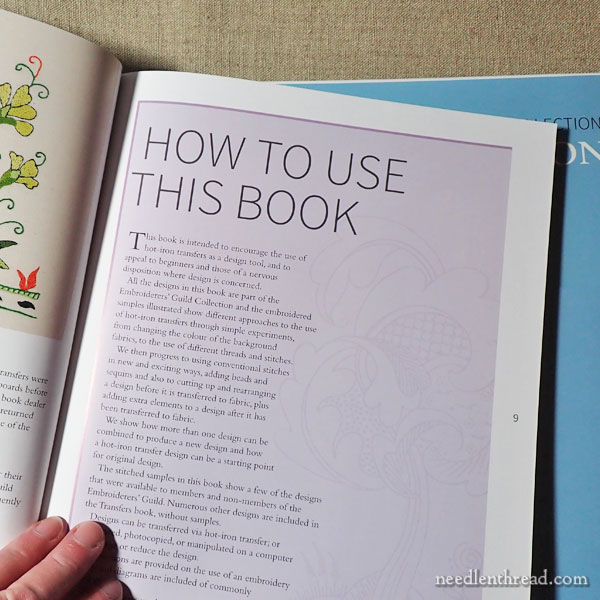
The Stitching Guide is a good place to start, when working with the iron-on collection. You’ll find out how to use the collection to your best advantage.
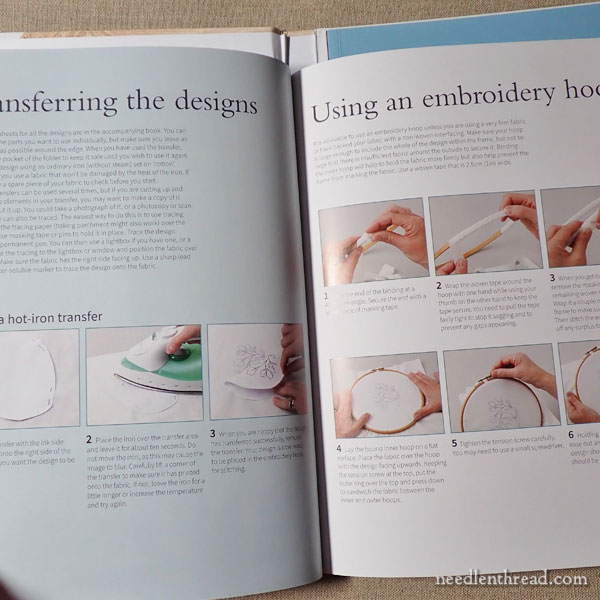
You’ll pick up the basics on how to use an iron-on transfer, as well as some basics on hand embroidery.
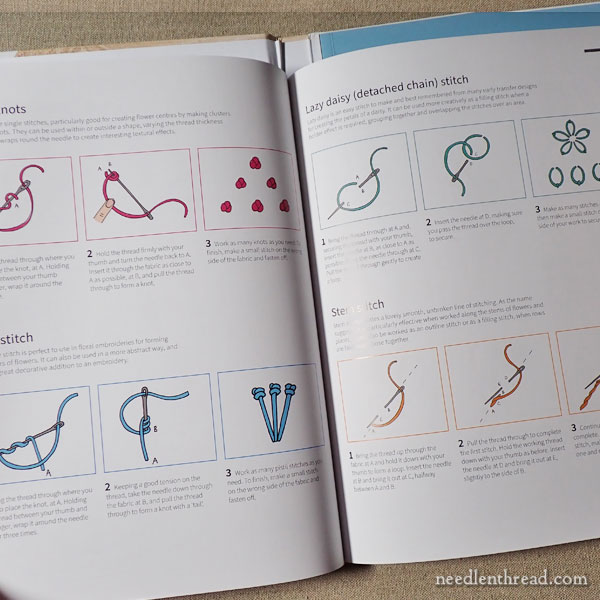
You’ll find a stitch dictionary with basic embroidery stitch diagrams to help you get started.
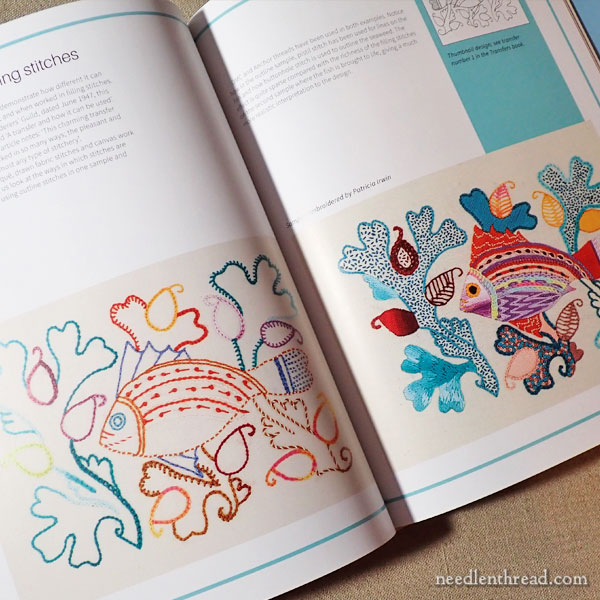
The Guide presents numerous ways one can approach these types of line drawings, giving examples of different outcomes depending on the approach you take.
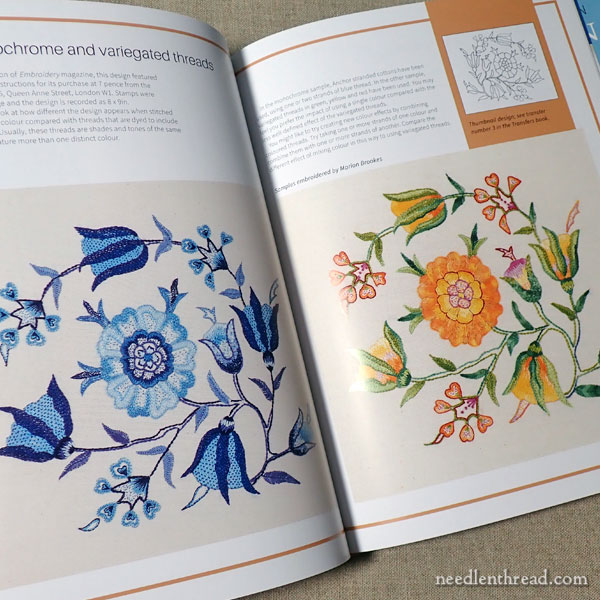
And while most of the embroidery examples presented are pretty basic, how far you take the needlework, how much you put into it, how complicated or simple you make it – this is all up to you.
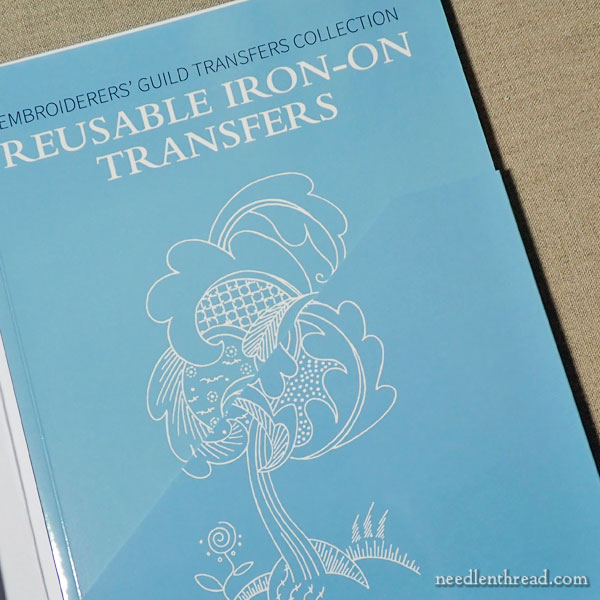
And then, of course, on the other side of the folio is the collection of iron-on transfers.
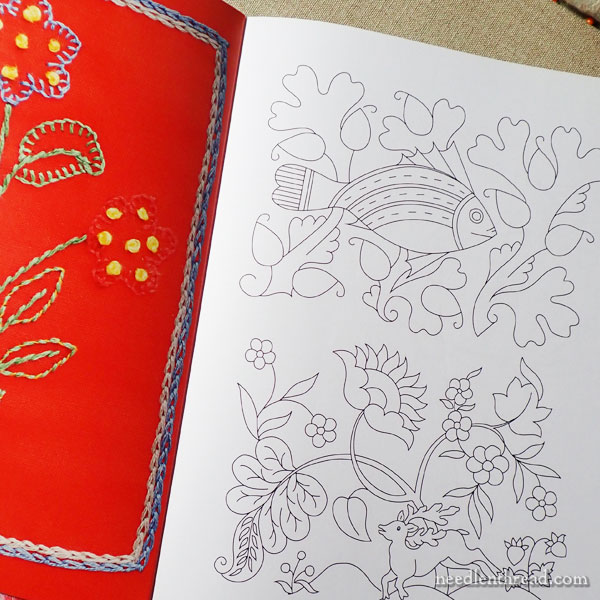
The designs in the collection cover quite a few design styles – from Jacobean to modern, whimsical, formal, and so forth. Some designs are better than others. What you like or don’t like will depend solely on your own tastes. But there is plenty for everyone here, I think!
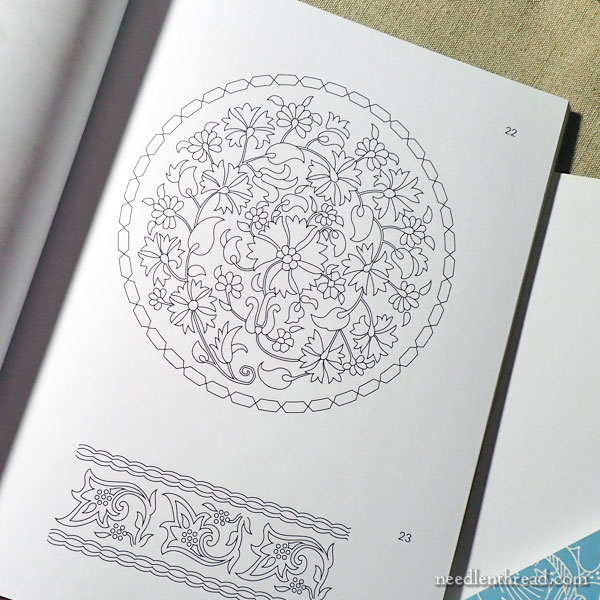
The transfers are reusable up to a certain point. I generally find that most modern transfers will give one very good transfer, followed by one pretty good transfer, followed by one “ok” transfer, and by the fourth… meh.
If you’re planning to repeat designs, your best bet is to photocopy the transfer before you use it, so that you have a copy of the design that you can trace if you run out of transfer-ability on the original.
In a Nutshell
Yes! This is a great book to own! Even considering my rant above, there really are no cons. After all, if you’re purchasing a transfer collection like this, you’re usually purchasing it to have a collection of transfers – and that’s what this book is. It’s a great value, with 90 designs at your fingertips to transfer, plus a book of tips and stitches to guide you through stitching them. What a great resource!
For those who are held back by the transfer process, you can’t go wrong!
Honor the Iron-On!
Where to Find It
You’ll find the Embroiderers’ Guild Transfers Collection available through various online book outlets:
If you’re in the States, you can find it listed here under my Amazon recommendations.
Worldwide, you’ll find it here through Book Depository, with free shipping.
This article contains affiliate links to online book sources, which means that Needle ‘n Thread receives a small commission on purchases made through those links, with no added cost to you. Thanks!







I guess it’s a good thing that when I consider buying books for the designs, the history section (if there is one) isn’t a big influence. I wonder if the tone of this book’s history section is an attempt at poking fun at their own lack of appreciation for the designs they let slip away. I hope it’s not that whoever wrote it is embarrassed that the EGA would present iron-on designs. But I confess, when I think of iron-on designs, the first thing that comes to mind is the kitchy kitchen towel designs from the company with initials A.M. Not disrespecting – I think I have most of them, plus the quilt block transfers, along with quite a few from other companies no longer in business.
I should probably clarify, it’s not the EGA. It’s the UK guild.
Incidentally, I have some gorgeous iron ons for cutwork, whitework, and various surface techniques from Italy and from Argentina. I also have old crewel designs from the mid-1900’s from the US, as well as early 1900’s designs featuring Society Silk type designs, as well as art nouveau designs. I know most people equate the iron-on with vintage “weekday chores” towels or state birds –
Which also have a legitimate place in the history and life of needlework- but they were also oh-so-much more!
Thanks for the clarification – I’m not sure how I saw Embroiderer’s Guild and made the jump to thinking the book is by the EGA.
Completely understandable! It’s all in the name! LOL!
Dear Mary
The book seems to have a lot going for it if you like transfers and as you say there is 90 transfers to choose from which is a lot and tips on how to stitch is always a great asset. I’ve never used an iron-on-transfer but I think it must be convenient way of getting a pattern on to fabric, which must be easier then the other options of drawing the pattern or other ways etc. Thank you for reviewing and sharing with us your thoughts on The Embroiderers’ Guild Transfers Collection book and for the photos of some of the patterns in the book. I hope you have a good break and that it is a relaxing time for you, look forward to hearing from you soon.
Regards Anita Simmance
As a Brit, I’m smiling to myself here, because I think you have just come face to face with a uniquely British phenomenon: middle-class snobbery. It’s mostly harmless, but can be mildly irritating nonetheless.
Welcome to the British class system !
Thanks for this review, the book looks like great fun – another one to add to my wish-list.
Oh trust me, it’s not just British! LOL! 🙂
Thank you for finding this book Mary. I am pretty aged and so really value all you write and share so generously. I do agree totally with your ‘ rant’. Many moons ago when I did quite a lot of hand embroidery, here in the UK, one always had iron on transfers for security and as you say avoiding the tricky stuff oneself. But I think that there has been an absolute dearth of iron on transfers for many years now. Hence the minimalizing of their reporting on iron on transfers?
Very best wishes and thanks
Margaret.
Love the new shop layout! Check the spelling on the “embroidery equipment” header
Thank you! LOL! Should be fixed soon!
Sounds rather weird. The post on their site about the launch doesn’t disparage them.
These transfers were certainly being sold when I was a kid, though presumably they weren’t EG ones!
Well, I wouldn’t say it disparages them entirely – it just reads strangely to me, as if it’s almost an apology for the focus on them. I don’t know! Probably just my interpretation….
I wish there was a way to iron-on an image from my printer! **sigh**
I’m going to try the printable Sulky. I’m going to do a set of images in different historic, shading techniques … and I want to do a set of critters in the various Viking Art stylez as a Visual Aid for a class I want to teach. And right now … fallout from my RA? … my hands shake too much to get nice straight lines.
Scurries off to see if you’ve ever reviewed the Sulky Stuff.
Susan